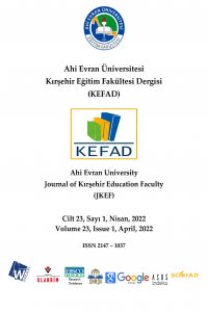Temel İş Sağlığı ve Güvenliği E-Dersi için Geliştirilmiş Video Ders Anlatımlarının Tasarım Analizi
Bu çalışmada, Temel İş Sağlığı ve Güvenliği Eğitimi (TİSGE) için hazırlanan video ders anlatımları, literatürde farklı boyutları vurgulayan sınıflandırmalara göre analiz edilerek video derslerin sahip olduğu özellikler ve tasarım bağlamında incelenmesi amaçlanmıştır. Çalışma, nitel araştırma yöntemlerinden durum çalışması deseni ile kurgulanmıştır. Araştırmanın örneklemini 80 TİSGE video ders anlatımı oluşturmuştur. Video ders anlatımlarının tasarımlarını sınıflandırmak amacıyla literatürdeki dört farklı sınıflandırma veri toplama aracı olarak kullanılmıştır. Videolara ait verinin toplanması ve analizi sürecinde içerik analizi ve doküman analizi yöntemi kullanılmıştır. Materyalin anlaşılması ve çözümlenmesi aşamasında videolar, veri toplama araçlarındaki kriter ve sınıflandırmalar doğrultusunda araştırmacılar tarafından kodlamışlardır. Elde edilen veriler sonucunda, temel alınan çerçevelerin video dersleri farklı ancak birbiriyle kesişmediği için tamamlayıcı boyutlarda incelediği görülmüştür. TİSGE videolarının dil bilimsel ve dil ötesi tasarım özellikleri bakımından sadece video sürelerinin farklılaştığı, diğer özelliklerin benzer olduğu görülmüştür. Videoların ders anlatım stili ve e-ders karakteristikleri bakımından, videoların farklı özelliklere sahip olduğu görülmüştür. Eğitmenin videodaki görünürlük özellikleri bakımından ise videoların tamamında eğitmen, slaytlarla yan yana ve yapay ortamda olduğu ve öğretimsel medya ve insan bedeni-kişileştirme açısından ise konuşan kafa-anlatıcı ve slayt içeren anlatım görülmüştür. Ancak bu iki sınıflandırmada yer alan kategorilerin, TİSGE video derslerin özelliklerini tam olarak karşılamadığı anlaşılmıştır. Video anlatımların detaylı incelenebileceği esnek ve kapsamlı bir çerçeveye ihtiyaç duyulduğu görülmüş olup bu bağlamda öneriler getirilmiştir.
Anahtar Kelimeler:
E-ders, Uzaktan eğitim, Video ders anlatımı, Video ders tasarımı, Video ders stili
Design Analysis of Video Lectures Developed for Basic Occupational Health and Safety E-Lecture
In this study, video lectures prepared for Basic Occupational Health and Safety Training (BOHST) were analyzed according to the classifications emphasizing different dimensions in the literature, and it was aimed to examine the video lectures in terms of their features and design. The study was designed with a case study design from qualitative research methods. The sample of the study consisted of 80 BOHST video lectures. In order to classify the designs of the video lectures, four different classifications in the literature were used as data collection tools. Content analysis and document analysis methods were used to collect and analyze the data of the videos. In the process of understanding and analyzing the material, the videos were coded by the researchers in line with the criteria and classifications in the data collection tools. As a result of the data obtained, it was seen that the frameworks taken as basis examined the video lessons in different but complementary dimensions because they did not intersect with each other. In terms of the linguistic and translanguaging design features of the BOHST videos, only the duration of the videos differed, while the other features were similar. In terms of the lecture style and e-lesson characteristics of the videos, it was observed that the videos had different characteristics. In terms of the visibility of the instructor in the video, the instructor was side by side with the slides and in an artificial environment in all of the videos, and in terms of instructional media and human body-personification, narration with talking head-narrator and slides was observed. However, it was understood that the categories in these two classifications did not fully meet the characteristics of the BOHST video lectures. The need for a flexible and comprehensive framework in which video lectures can be analyzed in detail has been seen and suggestions have been made in this context.
___
- Kim, J., Guo, P. J., Seaton, D. T., Mitros, P., Gajos, K. Z., & Miller, R. C. (2014). Understanding in-video dropouts and interaction peaks in online lecture videos. The first ACM conference on Learning@ scale conference, 31–40.
- ISSN: 2147-1037
- Yayın Aralığı: Yılda 3 Sayı
- Başlangıç: 2000
- Yayıncı: Ahi Evran Üniversitesi Kırşehir Eğitim Fakültesi
Sayıdaki Diğer Makaleler
Erken Dönemde Bilimsel Düşünme Eğilimini Değerlendirme Ölçeği Geçerlik Güvenirlik Çalışması
Hacer TEKERCİ, Gelengül HAKTANIR
G. Candan HAMURCU, Nazlı ALTUNCU
Yükseköğretimde Kalite Hizmetleri Kapsamında Eğitim Fakültesi Öğrenci Memnuniyetlerinin İncelenmesi
5E Öğretim Modelinin Piyano Performansı Öz Yeterlik Algısına Etki Durumunun Araştırılması
Pandemi Sonrası Psikolojik Stres ile Baş Etmede Öz-Belirlenim ve Farkındalık
Yabancı Dil Eğitiminde Web 2.0 Araçlarının kullanımına Yönelik Tutum Ölçeği’nin Geliştirilmesi
Öğretmenlerin Öğretim Programı Uyarlama Örüntülerinin Çeşitli Değişkenler Açısından İncelenmesi
Sınıf Öğretmenlerinin Harita Okuryazarlık Düzeylerinin Farklı Değişkenler Açısından İncelenmesi
